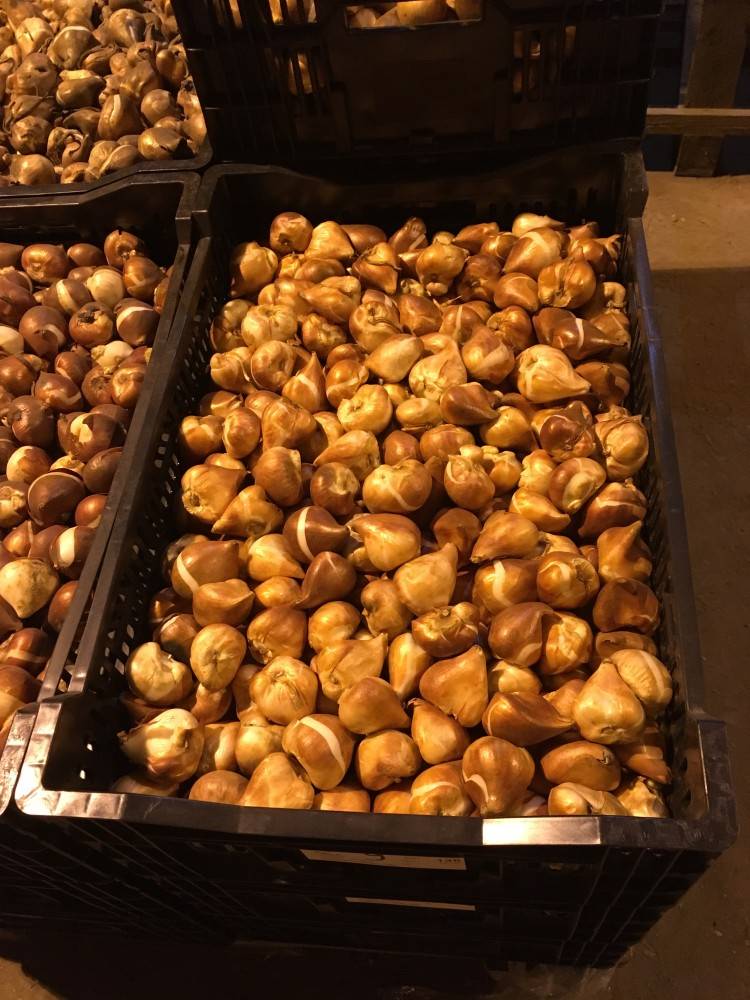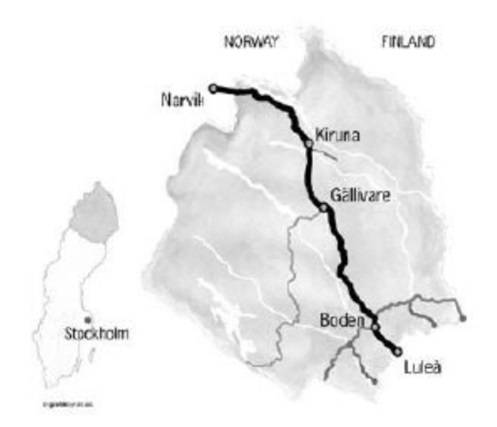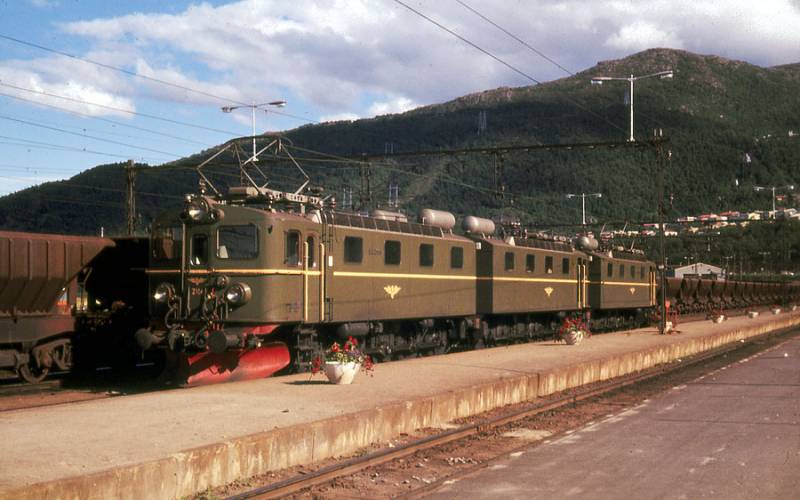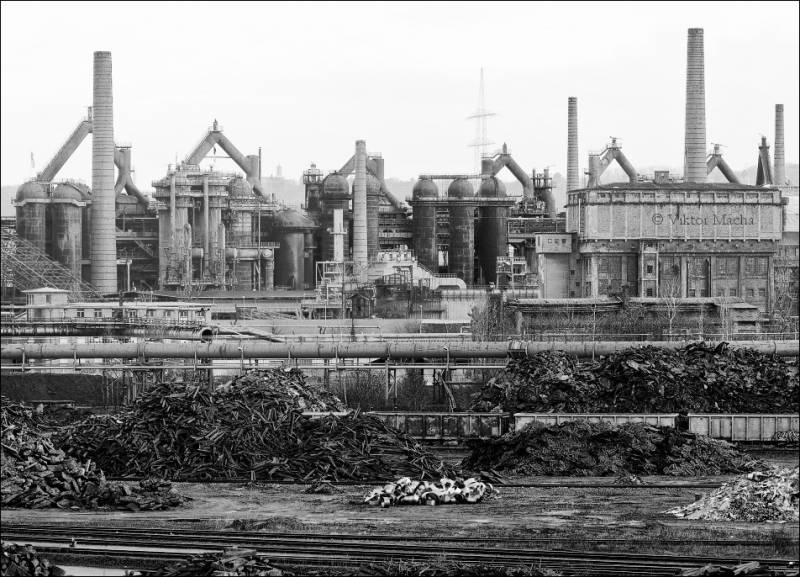Swedish trade with Germany: ore, coal and tulips
Trade between Sweden and Germany during the war is usually viewed exclusively through the prism of the supply of Swedish ore. Moreover, a pseudo-knowledge even developed around this issue, when it is asserted that the Swedish iron ore had a certain special quality, therefore the Germans appreciated it. There is some truth in this, however, even very knowledgeable authors do not know all the details regarding Swedish ore, which once determined its supply to Germany and its use in ferrous metallurgy.
In addition to ore, the Swedish-German trade included a number of other items. In addition, Sweden traded not only with Germany itself, but also with the occupied territories: Norway, Holland, Belgium. In other words, Sweden, despite its neutral status, was de facto an important part of the occupation economy built by the Germans during the war.
Swedes tried to please the Germans
Swedish neutrality was maintained, as already mentioned in previous article, on treaties with Germany, and there were quite a few of these treaties. Sweden entered into close economic relations with Germany in the mid-1920s, providing several loans to cover reparations payments under the Dawes and Jung plan.
After the Nazis came to power, a new era began, in which the Swedes quickly realized the aggressive nature of German politics, realized that they had no chance of opposing the Germans in any form, and therefore behaved very courteously towards German trade and economic interests.
The RGVA funds preserved two cases, which contain the minutes of negotiations between the Swedish and German government committees on payment and commodity circulation (Regierungsausschuß für Fragen des Zahlungs- und Warenverkehr) for 1938-1944. All protocols and materials to them are labeled "Vertraulich" or "Streng Vertraulich", that is, "Secret" or "Top secret".
The committees at the meetings held in Stockholm discussed the size of trade between the two countries, the volume and range of supplies from each side, so that the amount of payments from both sides would be balanced. In fact, it was interstate barter, since Germany had almost no freely convertible currency, and with the start of the war, the free quotation of the Reichsmark stopped. The Germans replaced the freie Reichsmark with the so-called. register mark (die Registermark), which was used when comparing the cost of mutual goods deliveries. The "register mark" appeared before the war and was used for some time together with the free Reichsmark, and, say, on the London Stock Exchange the value of the "register mark" was 56,5% of the free mark at the end of 1938 and 67,75% on the last peace day , 30 August 1939 (Bank für internationale Zahlungsausgleich. Zehnter Jahresbericht, 1. April 1939 - 31-März 1940. Basel, 27. Mai 1940, S. 34).
After discussing all the issues and agreeing on the volume and cost of supplies, the commissions drew up a protocol, which was binding on both parties. The bodies authorized for foreign trade in both countries (in Germany these were the sectoral Reichsstelle) were obliged to authorize imports and exports only within the framework of the concluded agreements. Buyers of imported goods paid for them in national currency, in Reichsmarks or Swedish kronor, and exporters received payment for their products in national currency. Banks in Sweden and Germany netted deliveries and made other payments as needed.
Such meetings were held regularly, since the trading plan was drawn up for each year. Therefore, the minutes of these negotiations reflected many aspects of the Swedish-German trade during the war.
In trade agreements with Germany, the Swedes paid great attention to the ongoing territorial changes. Let not the next day, but rather quickly German representatives arrived in Stockholm and an agreement was concluded on trade in new conditions. For example, on March 12-13, 1938, Austria joined the Reich, and on May 19-21, 1938, negotiations were held on payment and commodity circulation with the former Austria (RGVA, f. 1458, op. 44, d. 1, l. 8 ).
On March 15, 1939, the Czech Republic was occupied and part of its territory was turned into the Protectorate of Bohemia and Moravia. From May 22 to May 31, 1939, the issue of trade with this protectorate was discussed in Stockholm, the parties agreed to carry out settlements in free currency (RGVA, f. 1458, op. 44, d. 1, l. 42). On June 3, 1939, a separate trade protocol was signed with the Sudetenland, included in the territory of the Reich.
These territorial changes could have been denied, especially in the case of Czechoslovakia, and this would have had little impact on Swedish-German trade. However, the Swedes were clearly trying to please Germany, as indicated at least by the protocol on trade with the Sudetenland. It is unlikely that Swedish trade interests in this region, cut off from Czechoslovakia, were so great as to be considered separately, but the Swedes did this in order to demonstrate their position friendly to Germany.
At the end of 1939, the Germans thanked the Swedes. On December 11-22, 1939, negotiations took place in Stockholm, in which a trade procedure was developed, which was then used throughout the war. On January 1, 1940, all previous protocols were canceled and a new protocol was introduced, already with a delivery plan. Sweden was granted the right to export to the new Greater German Reich and territories under its control in the amount of exports to Germany, Czechoslovakia and Poland in 1938. Swedish interests did not suffer from the start of the war (RGVA, f. 1458, op. 44, d. 1, l. 63).
What Germany and Sweden Traded
At the end of 1939, Sweden and Germany agreed that they would sell to each other during the war.
Sweden could export to Germany:
Iron ore - 10 million tons.
Charcoal iron - 20 thousand tons.
Pine oil (Tallöl) - 8 thousand tons.
Ferrosilicon - 4,5 thousand tons.
Silicomanganese - 1 thousand tons.
Germany could export to Sweden:
Bituminous coal - up to 3 million tons.
Coke - up to 1,5 million tons.
Rolled steel - up to 300 thousand tons.
Coke iron - up to 75 thousand tons.
Potash salts - up to 85 thousand tons.
Glauber's salt - up to 130 thousand tons.
Edible salt - up to 100 thousand tons.
Soda ash - up to 30 thousand tons.
Caustic soda - up to 5 thousand tons.
Liquid chlorine - up to 14 thousand tons (RGVA, f. 1458, op. 44, d. 1, l. 63-64).
In January 1940, another meeting was held at which the cost of the supplies was calculated. From the Swedish side - 105,85 million Reichsmarks, from the German side - 105,148 million Reichsmarks (RGVA, f. 1458, op. 44, file 1, l. 74). German deliveries were less by 702 thousand Reichsmarks. However, the Swedes almost always made additional requests related to the supply of small quantities of various chemicals, pharmaceuticals, machinery and equipment; they were satisfied with this remainder.
By the end of the war, Swedish-German trade had grown significantly in value and new commodity items appeared in it, which somewhat changed the structure of trade. As a result of the negotiations December 10, 1943 - January 10, 1944, the trade turnover was as follows:
Swedish export to Germany:
Iron ore - 6,2 million tons (1944 deliveries), - 0,9 million tons (the remainder of 1943).
Burnt pyrite - 150 thousand tons.
Ferrosilicon - 2,8 thousand tons.
Pig iron and steel - 40 thousand tons.
Zinc ore - 50-55 thousand tons.
Bearings - 18 million Reichsmarks.
Machine tools - 5,5 million Reichsmarks.
Bearing machines - 2,6 million Reichsmarks.
Wood - 50 million Reichsmarks.
Cellulose for artificial fiber - 125 thousand tons.
Sulphated cellulose - 80 thousand tons.
German exports to Sweden:
Bituminous coal - 2,240 million tons.
Coke - 1,7 million tons.
Rolled steel - 280 thousand tons.
Potash salts - 41 thousand tons.
Glauber's salt - 50 thousand tons.
Rock and table salt - 230 thousand tons.
Soda ash - 25 thousand tons.
Calcium chloride - 20 thousand tons (RGVA, f. 1458, op. 44, d. 2, l. 54-56).
From this data, boring at first glance, a couple of interesting conclusions can be drawn.
First, food, oil and petroleum products are completely absent in the Swedish-German trade. If the lack of food is more or less explained by the fact that Sweden provided itself and did not need to be imported, then the lack of oil products is surprising. Sweden needed about 1 million tons of oil products per year, while Germany did not supply them. Hence, there were other sources. Most likely, transit from Romania and Hungary, but not only. Also, the Swedes had a "window" for the purchase of oil products, but where they purchased them and how they were delivered remains unknown.
Second, the Swedes and Germans traded almost exclusively in industrial raw materials, chemicals and equipment. A large amount of salt that Sweden bought in Germany went to the needs of the agro-industrial sector: potash salts - fertilizer, edible salt - preservation of fish and meat, calcium chloride - a food additive in canning vegetables, meat, dairy products and bread, Glauber's salt - most likely in total, use in large refrigeration plants. Soda ash is also a food additive and a component of detergents. Caustic soda is also a detergent. Thus, a significant part of the trade was aimed at strengthening the food situation in Sweden and, probably, creating food stocks, which is understandable in those conditions.
Barter economy
With the mediation of Germany, Sweden also traded with the occupied territories. Just two weeks after the final occupation of Norway, which took place on June 16, 1940, negotiations were held in Stockholm on July 1-6, 1940 to resume Swedish-Norwegian trade. The parties agreed, and from that moment on, Sweden's trade with Norway was conducted on the same basis as with Germany, that is, through barter.
The volume of trade was small, about 40-50 million Reichsmarks per year, and also consisted almost entirely of raw materials and chemicals. In the first half of 1944, Norway supplied to Sweden sulfur and pyrite, nitric acid, calcium carbide, calcium nitrate, aluminum, zinc, graphite and so on. Swedish exports to Norway consisted of machinery and equipment, cast iron, steel and metal products (RGVA, f. 1458, op. 44, d. 2, l. 12).
Likewise, and at about the same time, Swedish trade with occupied Holland and Belgium was organized. It was somewhat more interesting than with Norway, and completely different in structure.
Sweden mainly exported to Holland sawn timber and pulp in the amount of 6,8 million Reichsmarks, or 53,5% of the total export, amounting to 12,7 million Reichsmarks.
Swedish purchases in Holland:
Tulip bulbs - 2,5 million Reichsmarks.
Food salt - 1,3 million Reichsmarks (35 thousand tons).
Artificial silk - 2,5 million Reichsmarks (600 tons).
Radio equipment - 3,8 million Reichsmarks.
Machinery and equipment - 1 million Reichsmarks (RGVA, f. 1458, op. 44, d. 2, l. 95).
The trade with Belgium was much more modest, and the whole exchange had a volume of only 4,75 million Reichsmarks.
Sweden exported pulp, machinery and bearings to Belgium and received from there:
Tulip bulbs - 200 thousand Reichsmarks.
Photo materials - 760 thousand Reichsmarks.
X-ray film - 75 thousand Reichsmarks.
Glass - 150 thousand Reichsmarks.
Machinery and equipment - 450 thousand Reichsmarks.
Artificial silk - 950 thousand Reichsmarks (240 tons).
Calcium chloride - 900 thousand Reichsmarks (15 thousand tons) - (RGVA, f. 1458, op. 44, d. 2, l. 96).
Purchases of tulip bulbs for 2,7 million Reichsmarks are certainly impressive. Someone fought, and someone decorated flower beds.

Germany tried to bring all trade in continental Europe under her control. Taking advantage of the fact that during the war all sea and rail transport in Europe was under German control, German trade authorities acted as intermediaries in a wide variety of transactions between different countries. Sweden could supply different consignments of goods in exchange for other goods. The Germans created a kind of trading bureau, in which applications and proposals were brought together and it was possible to choose what to change for. For example, Bulgaria asked Sweden for 200 tons of shoe nails and 500 tons of shoe shoes in exchange for sheepskin leather. Spain offered Sweden to supply 200 tons of pulp in exchange for 10 tons of sweet almonds. There was also a proposal from Spain to supply bearings in exchange for lemons (RGVA, f. 1458, op. 44, d. 17, l. 1-3). And so on.
Such a barter economy, apparently, has received a fairly large development, all countries and territories of Europe were involved in it, regardless of their status: neutrals, Germany's allies, occupied territories, protectorates.
The intricacies of the iron ore trade
Much has been written about Sweden's export of iron ore to Germany, but mostly in the most general words and expressions, but technical details are very difficult to find. The protocols of negotiations between the Swedish and German government commissions retained some important details.
First. Sweden supplied Germany mainly with phosphorous iron ore. The ore was divided into grades depending on the content of impurities, mainly phosphorus, and this was taken into account in the supplies.
For example, in 1941, Sweden had to supply the following grades of iron ore.
High in phosphorus:
Kiruna-D - 3180 thousand tons.
Gällivare-D - 1250 thousand tons.
Grängesberg - 1300 thousand tons.
Low in phosphorus:
Kiruna-A - 200 thousand tons.
Kiruna-B - 220 thousand tons.
Kiruna-C - 500 thousand tons.
Gällivare-C - 250 thousand tons.
Apatite mining tailings - 300 thousand tons (RGVA, f. 1458, op. 44, d. 1, l. 180).
Total: 5730 thousand tons of phosphorous iron ore and 1470 thousand tons of low-phosphorus ore. The ore with low phosphorus content accounted for about 20% of the total volume. In principle, it is not difficult to find out that the ore in Kiruna is phosphorous. But in numerous works on stories of the German economy during the war, this moment is not noted by anyone, although it is very important.
Most of the German iron and steel industry produced pig iron from phosphorous ore and then processed it into steel by the Thomas process in converters with compressed air blowing and adding limestone. In 1929, out of 13,2 million tons of cast iron, Thomas-cast iron (the Germans used a special term for it - Thomasroheisen) accounted for 8,4 million tons, or 63,6% of the total production (Statistisches Jahrbuch für die Eisen- und Stahlindustrie. 1934 Düsseldorf, Verlag Stahliesen mbH, 1934 S. 4). The raw material for it was imported ore: either from the mines of Alsace and Lorraine, or from Sweden.
However, the Alsatian and Lorraine ore, which the Germans captured again in 1940, was very poor, 28-34% iron content. The Swedish Kiruna ore was, on the contrary, rich, from 65 to 70% iron content. The Germans, of course, could also melt the poor ore. In this case, the coke consumption increased 3-5 times, and the blast furnace operated, in fact, as a gas generator, with a by-product of pig iron and slag. But one could simply mix rich and poor ores and get a charge of quite decent quality. The addition of 10-12% lean ore did not worsen the smelting conditions. Therefore, the Germans bought Swedish ore not only for the sake of a good yield of pig iron, but also for the possibility of economical use of the Alsatian-Lorraine ore. In addition, phosphorus fertilizer arrived along with the ore, which was beneficial, since phosphorites were also imported in Germany.
Thomas steel, however, was more fragile than grades smelted from ore with a low phosphorus content, so it was mainly used for construction metal rolling and sheet.
Second. The enterprises that processed phosphorous ore were concentrated in the Rhine-Westphalian region, which caused the requirement for sea transport. Almost 6 million tons of ore was to be delivered to the mouth of the Ems river, from where the Dortmund-Ems canal begins, connecting with the Rhine-Herne canal, on which the largest German metallurgical centers are located.
With the seizure of the Norwegian port of Narvik, it would seem that there should be no problems with export. But problems arose. If before the war 5,5 million tons of ore went through Narvik, and 1,6 million tons of ore through Luleå, then in 1941 the situation changed to the opposite. Narvik sent 870 thousand tons of ore, and Luleå - 5 million tons (RGVA, f. 1458, op. 44, d. 1, l. 180). This was possible because both ports were connected to Kirunavara by an electrified railway.

The reason was obvious. The North Sea became unsafe and many captains refused to go to Narvik. In 1941, they began to pay a military premium for the delivery of goods, but this did not particularly help. The premium rate for Narvik was from 4 to 4,5 Reichmarks per ton of cargo, and it did not at all compensate for the risk of getting a torpedo in the side or a bomb in the hold. Therefore, the ore went to Luleå and other Baltic ports in Sweden. From there, the ore was transported by a safer route from the Baltic along the Danish coast or along the Kiel Canal to its destination.
Freight rates were much more lenient than in Finland. For example, the Danzig-Luleå coal freight ranged from 10 to 13,5 crowns per ton of coal and from 12 to 15,5 crowns per ton of coke (RGVA, f. 1458, op. 44, d. 1, l. 78-79) ... The rates were approximately the same for ore. The ratio of the Swedish krona to the "Registered Reichsmark", as can be calculated from the minutes of January 12, 1940, was 1,68: 1, that is, 1 krone 68 ore per Reichsmark. Then the cheap freight Danzig - Luleå was 5,95 Reichsmarks per ton, and the expensive one was 9,22 Reichsmarks. There was also a commission on freight: 1,25% and 0,25 Reichsmarks per tonne was the fee for storage in a warehouse in the port.
Why was Finnish freight so expensive compared to Swedish? Firstly, the danger factor: the route to Helsinki passed near enemy (that is, Soviet) waters, there could be attacks from the Baltic Fleet and aviation... Secondly, the return traffic from Finland was obviously less and irregular, in contrast to the transport of coal and ore. Thirdly, there was clearly the influence of high political circles, in particular Goering: Swedish ore, as a vital resource for the Reich, had to be transported cheaply, but let the Finns be ripped off by freight companies as they want.
Third. The fact that the ore went to Luleå had negative consequences. Before the war, Narvik had three times the capacity, huge ore storage facilities, and it did not freeze. Luleå was a small port, with less developed storage and transshipment facilities, and the Gulf of Bothnia was frozen. This all limited transportation.
As a result, the Germans started with Napoleonic plans, setting a limit on the export of Swedish ore at the level of 11,48 million tons for 1940. The next year, at the negotiations on November 25 - December 16, 1940, the German position changed: the restrictions were lifted (RGVA, f. 1458, op. 44, d. 1, l. 119). It turned out that so much ore cannot be taken out of Sweden. Germany received about 1940 million tons of iron ore in 7,6, and there was still a shortfall of 820 thousand tons of ore. For 1941, an agreement was reached on the supply of 7,2 million tons of ore with additional purchases of 460 thousand tons, and the entire volume with the remainder of last year reached 8,480 million tons. At the same time, the possibilities for export were estimated at 6,85 million tons, that is, by the end of 1941, 1,63 million tons of unloaded ore should have accumulated (RGVA, f. 1458, op. 44, d. 1, l. 180).
And in 1944 the parties agreed on the supply of 7,1 million tons of ore (6,2 million tons of mined and 0,9 million tons of the remaining supplies of 1943). 1,175 million tons were shipped by the end of March 1944. A monthly loading plan was drawn up for the remaining 5,9 million tons for April-December 1944, within which loading was to increase 2,3 times, from 390 thousand tons to 920 thousand tons per month (RGVA, f. 1458, op. 44, d. 2, l. 4). However, the Germans also severely under-supplied coal to Sweden. At the end of December 1943, they had 1 million tons of undelivered coal and 655 thousand tons of coke. These remnants were included in the treaty for 1944 (RGVA, f. 1458, op. 44, d. 2, l. 63-64).
In general, from a more detailed examination of the intricacies of the Swedish-German trade, it becomes not only clear and obvious, but also well perceptible that Sweden, despite its neutral status, was de facto part of the German occupation economy. It is worth noting that the part is very profitable. Germany spent on Swedish trade the resources she had in excess (coal, mineral salts), and did not spend scarce resources, such as oil or oil products.


Information